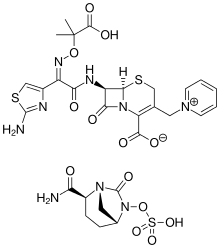Ceftazidime/avibactam
Ceftazidime/avibactam, sold under the brand name Avycaz among others, is a combination medication composed of ceftazidime, a cephalosporin antibiotic, and avibactam, a β-lactamase inhibitor.[2] It is used to treat complicated intra abdominal infections, urinary tract infections, and pneumonia.[2][3] It is only recommended when other options are not appropriate.[2] It is given by injection into a vein.[2]
 | |
| Combination of | |
|---|---|
| Ceftazidime | Cephalosporin antibiotic |
| Avibactam | β-lactamase inhibitor |
| Clinical data | |
| Trade names | Avycaz, Zavicefta, others[1] |
| AHFS/Drugs.com | Monograph |
| MedlinePlus | a615018 |
| License data | |
| Pregnancy category |
|
| Routes of administration | Intravenous infusion |
| ATC code | |
| Legal status | |
| Legal status |
|
| Identifiers | |
| PubChem CID | |
| KEGG | |
| | |
Common side effect include nausea, fever, liver problems, headache, trouble sleeping, and pain at the site of injection.[2] Severe side effects may include anaphylaxis, seizures, and Clostridium difficile-associated diarrhea.[2] While use appears to be safe in pregnancy the medication has not been well studied in this group.[4] Doses should be adjusted in those with kidney problems.[5] Ceftazidime works by interfering with the building of the bacterial cell wall well avibactam works by preventing ceftazidime's breakdown.[2]
The combination was approved for medical use in the United States and Europe in 2015.[2][3] The combination is on the World Health Organization's List of Essential Medicines, the safest and most effective medicines needed in a health system.[6] In the United States a course of treatment generally costs between US$7,500 to US$15,000 as of 2016.[5] In the United Kingdom this amount costs the NHS about £1,800 to £3,600 as of 2019.[7]
Medical use
Ceftazidime/avibactam is used to treat certain multidrug-resistant gram-negative infections.[8]
Ceftazidime/avibactam is used for the treatment of:
- complicated intra-abdominal infections. In these cases it is often used in combination with metronidazole, which provides coverage for anaerobic pathogens.[5]
- complicated urinary tract infections, including acute pyelonephritis, in adults.
- hospital-acquired bacterial pneumonia and ventilator-associated bacterial pneumonia.[9]
Bacterial activity
For many bacterial infections, it offers little or no advantage over ceftazidime monotherapy, due to the widespread expression of resistance mechanisms other than β-lactamase production. These include Haemophilus, Moraxella and Neisseria pathogens, and infections caused by Acinectobacter baumannii.[10]
The antibacterial spectrum of ceftazidime/avibactam includes nearly all Enterobacteriaceae, including ceftazidime-resistant strains. The activity of ceftazidime/avibactam against the important hospital pathogen Pseudomonas aeruginosa is variable, due to the potential presence of other resistance mechanisms in addition to β-lactamase production. Synergy was observed for avibactam with ceftazidime in the Burkholderia cepacia complex.[11]
Adverse events
When used to treat life-threatening infections, ceftazidime/avibactam is more likely than carbapenem antibiotics to cause serious adverse events, including worsening kidney function and gastrointestinal adverse effects.[12]
Mechanism of action
Bacterial resistance to cephalosporins is often due to bacterial production of β-lactamase enzymes that deactivate these antibiotics. Avibactam inhibits some (but not all) bacterial ß-lactamases. Also, some bacteria are resistant to cephalosporins by other mechanisms, and therefore avibactam doesn't work. Avibactam is not active against New Delhi metallo-β-lactamase 1 (NDM-1).[13] Avibactam inhibits Klebsiella pneumoniae carbapenemases (KPCs), and AmpC-type β-lactamases, which are resistant to the other clinically-available β-lactamases, tazobactam and clavulanic acid.[14]
Regulatory
It was granted approval for marketing in the United States by the Food and Drug Administration (FDA) in February 2015.[15] It was granted approval for marketing in Europe by the European Medicines Agency in 2016. During its clinical development, ceftazidime/avibactam was designated as a Qualified Infectious Disease Product under the Generating Antibiotic Incentives Now provision of the Food and Drug Administration Safety and Innovation Act.[16][17] Development of ceftazidime/avibactam was fast-tracked by the FDA due to the shortage of drugs for treatment of infections due to antibiotic-resistant bacteria.
References
- "Briefing package: ceftazidime-avibactam. Anti-infective drugs advisory committee meeting" (PDF). U.S. Food and Drug Administration (FDA). Archived from the original (PDF) on 30 June 2015. Retrieved 27 June 2015.
- "Ceftazidime and Avibactam Sodium Monograph for Professionals". Drugs.com. Retrieved 25 October 2019.
- "Application for inclusion of ceftazidime-avibactam" (PDF). WHO. Retrieved 25 October 2019.
- "Avibactam / ceftazidime (Avycaz) Use During Pregnancy". Drugs.com. Retrieved 25 October 2019.
- Mosley JF, 2nd; Smith, LL; Parke, CK; Brown, JA; Wilson, AL; Gibbs, LV (August 2016). "Ceftazidime-Avibactam (Avycaz): For the Treatment of Complicated Intra-Abdominal and Urinary Tract Infections". Pharmacy and Therapeutics. 41 (8): 479–83. PMC 4959616. PMID 27504064.
- Organization, World Health (2019). "World Health Organization model list of essential medicines: 21st list 2019". hdl:10665/325771. Cite journal requires
|journal=(help) - British national formulary : BNF 76 (76 ed.). Pharmaceutical Press. 2018. pp. X. ISBN 9780857113382.
- Lagacé-Wiens P, Walkty A, Karlowsky JA (2014). "Ceftazidime-avibactam: an evidence-based review of its pharmacology and potential use in the treatment of Gram-negative bacterial infections". Core Evid. 9: 13–25. doi:10.2147/CE.S40698. PMC 3908787. PMID 24493994.
- https://www.allergan.com/assets/pdf/avycaz_pi
- Lagacé-Wiens P, Walkty A, Karlowsky JA (2014). "Ceftazidime-avibactam: an evidence-based review of its pharmacology and potential use in the treatment of Gram-negative bacterial infections". Core Evid. 9: 13–25. doi:10.2147/CE.S40698. PMC 3908787. PMID 24493994.
- Mushtaq S, Warner M, Livermore DM (2010). "In vitro activity of ceftazidime+NXL104 against Pseudomonas aeruginosa and other non-fermenters". J Antimicrob Chemother. 65 (11): 2376–2381. doi:10.1093/jac/dkq306. PMID 20801783.
- Sternbach N, Leibovici Weissman Y, Avni T, Yahav D (August 2018). "Efficacy and safety of ceftazidime/avibactam: a systematic review and meta-analysis". J. Antimicrob. Chemother. 73 (8): 2021–2029. doi:10.1093/jac/dky124. PMID 29659836.
- Lohans CT, Brem J, Schofield CJ (December 2017). "New Delhi Metallo-β-Lactamase 1 Catalyzes Avibactam and Aztreonam Hydrolysis". Antimicrob. Agents Chemother. 61 (12). doi:10.1128/AAC.01224-17. PMC 5700305. PMID 28971873.
- "Clinical Review, NDA 206494, Ceftazidime-avibactam" (PDF). Food and Drug Administration (FDA). 2015-02-18.
- "AVYCAZ (ceftazidime-avibactam) approval letter" (PDF). Food and Drug Administration (FDA). 2015-02-25. Retrieved September 10, 2019.
- "FDA approves new antibacterial drug Avycaz" (Press release). Food and Drug Administration (FDA). Archived from the original on 2015-11-17. Retrieved 2015-11-16.
- "FDA clears Actavis' combination antibacterial Avycaz". FirstWord Pharma. Retrieved 2015-11-16.